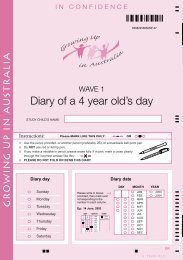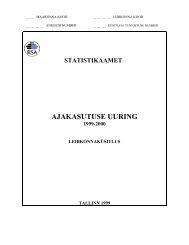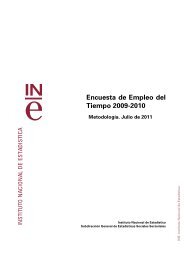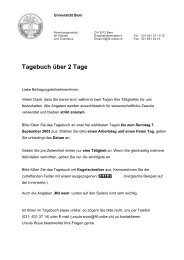multinational time use study user's guide and documentation
multinational time use study user's guide and documentation
multinational time use study user's guide and documentation
- No tags were found...
You also want an ePaper? Increase the reach of your titles
YUMPU automatically turns print PDFs into web optimized ePapers that Google loves.
ELOC = 5ELOC = 6ELOC = 7ELOC = 8ELOC = 9at services or shopsat restaurant, café, bar, pubat place of worshiptravellingother locationsTable 2.4 details the location codes. We draw these location codes both fromseparate location variables <strong>and</strong> from imbedded information in the original activitycodes. Users should note that the degree of specification about whether anactivity in inside or outside is highly variable by survey, <strong>and</strong> caution should be<strong>use</strong>d with this variable for cross-country <strong>and</strong> cross-<strong>time</strong> analysis. During thisprocess, we have checked any inconsistencies between the original locationcodes <strong>and</strong> the imbedded activity codes, <strong>and</strong> we comment on such cases in theconversion programmes for each survey. Where some location codes we aim toidentify are collapsed into a general “other” code, where possible we <strong>use</strong> theactivity codes to break down “other” locations. As examples, if there is no codefor school, but the activity is formal schooling <strong>and</strong> takes place away from home,we code the location as school. Similarly, if the activity is attend religious service<strong>and</strong> the location is other not at home, we code this activity as at a place ofworship. If the diarist was travelling (including on foot <strong>and</strong> by bicycle), ELOC hasthe value of 8.ICT: Used information communication technology during activityWe include a marker of whether the diarist <strong>use</strong>d one or more ICTs during theactivity. In some recent surveys, the diary included a column marking whetherthe diarist <strong>use</strong>d ICTs. If such a column is available, then we <strong>use</strong> this column tocreate this 0/1 marker variable. In many cases, however, we can only identify thisinformation from the activity code list. The HETUS surveys, for example,separately coded playing social games from playing social computer games, <strong>and</strong>doing ho<strong>use</strong>hold accounts <strong>and</strong> banking on the computer/over the internet fromdoing ho<strong>use</strong>hold accounts <strong>and</strong> banking on paper. In cases where theidentification of ICT <strong>use</strong> is available in more than one format (a dedicated columnas well as in activity codes), we <strong>use</strong> all forms of available information to createthis marker. As is the case with the mode of transport, where the diarist may notwrite down the word “commute” in the activity column if they have written “drovecar to work” in the location column, some diarists similarly might write “internetbanking” as their activity but not bother to tick the <strong>use</strong>d a computer box.Nevertheless, such an identification of the activity does give <strong>use</strong> sufficientinformation to know that the diarist <strong>use</strong>d ICTs during this episode.ICT valuesDescription








